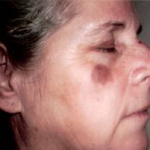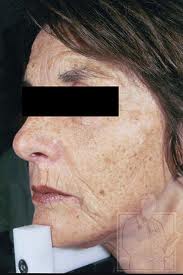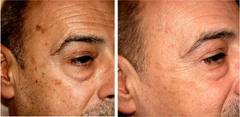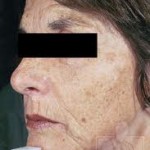Age spots — also called liver spots and solar lentigines — are flat gray, brown or black spots. They vary in size and usually appear on the face, hands, shoulders and arms — areas most exposed to the sun. Though age spots are very common in adults older than age 40, they can affect younger people as well.
True age spots are harmless and don’t need treatments, but they can look like cancerous growths. For cosmetic reasons, age spots can be lightened with skin-bleaching products or removed. However, preventing age spots — by avoiding the sun and using sunscreen — may be the easiest way to maintain your skin’s youthful appearance and to avoid these dark skin spots.
Symptoms
Age spots typically develop in people with a fair complexion, but they can be seen in those with darker skin. Age spots:
- Are flat, oval areas of increased pigmentation
- Are usually brown, black or gray
- Occur on skin that has had the most sun exposure over the years, such as the backs of hands, tops of feet, face, shoulders and upper back
Age spots range from freckle-size to more than a half inch (1 centimeter) across and can group together, making them more prominent.
When to see a doctor
You may not like the way they look, but age spots are usually harmless and don’t require medical care. However, your doctor should evaluate spots that are dark or have changed in appearance, because these changes can be signs of melanoma, a serious form of skin cancer.
It’s best to have any new skin changes evaluated by a doctor, especially if a spot or lesion:
- Is darkly pigmented
- Is rapidly increasing in size
- Has an irregular border
- Has an unusual combination of colors
- Is accompanied by itching, redness, tenderness or bleeding
Causes
Age spots are caused primarily by years of exposure to ultraviolet (UV) light from the sun. The use of commercial tanning lamps and tanning beds can also contribute to the development of age spots.
The pigment in the upper layer of skin (epidermis) that gives your skin its normal color is called melanin. UV light accelerates the production of melanin, creating a tan that helps protect deeper layers of skin from UV rays.
On areas of the skin that have years of frequent and prolonged sun exposure, age spots appear when melanin becomes “clumped” or is produced in particularly high concentrations. In addition to sun exposure, simply becoming older can cause the extra production of melanin.
Your genetic makeup may also play a role in how susceptible you are to the development of age spots.
Risk factors
 Although anyone can develop age spots, you may be more likely to develop the condition if you:
Although anyone can develop age spots, you may be more likely to develop the condition if you:
- Have light-colored or fair skin
- Have a history of frequent or intense sun exposure or sunburn
Preparing for your appointment
You’re likely to start by seeing your family doctor or primary care doctor. However, in some cases when you call to set up an appointment, you may be referred to a specialist in skin diseases (dermatologist).
What to expect from your doctor
Your doctor is likely to ask you a number of questions, such as:
- When did you first notice the spots on your skin?
- Did the spots appear gradually or quickly?
- Have you noticed any other changes in the appearance of your skin?
- Is the condition itchy, tender or otherwise bothersome?
- Have you experienced frequent or severe sunburns?
- How often are you exposed to sun or UV radiation?
- Do you regularly protect your skin from UV radiation?
- What kind of sun protection do you use?
Questions for your doctor
 Questions you may want to ask your doctor include:
Questions you may want to ask your doctor include:
- What suspicious changes in my skin should I look for?
- If the spots are, in fact, age spots, what can I do to improve the appearance?
- What results can I expect?
Tests and diagnosis
Diagnosing age spots may include:
- Visual inspection. Your doctor can usually diagnose age spots by visually inspecting your skin.
- Skin biopsy. If there’s any doubt, your doctor may do other tests, such as a skin biopsy. During a skin biopsy, your doctor takes a small sample of your skin (biopsy) for microscopic analysis. A skin biopsy is usually done in a doctor’s office, using a local anesthetic.
Other conditions
Other conditions that can look similar to age spots and that your doctor may need to rule out include the following:
- Moles. Although they often appear as small, dark brown spots, moles (nevi) vary in color and size. They can be raised or flat and can develop almost anywhere on your body.
- Seborrheic keratoses. These tan, brown or black growths have a wart-like or waxy, pasted-on appearance and range in size from very small to more than 1 inch (2.5 centimeters) across.
- Lentigo maligna. A type of skin cancer known as lentigo maligna melanoma can develop in areas of long-term sun exposure. Lentigo maligna starts as tan, brown or black lesions that slowly darken and enlarge. They tend to have an irregular border and uneven coloring, and they may be slightly raised.


